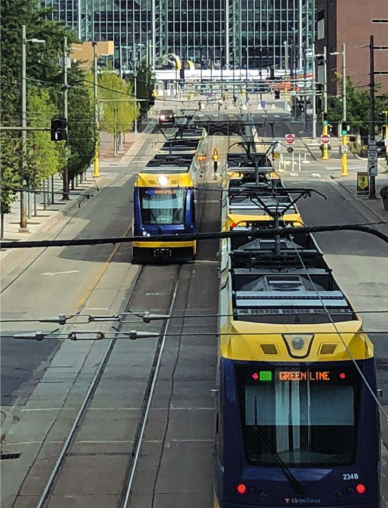Toll Free + 1 (800) 245-7660
Words | Jon Meusch and Gustavo de la Pena, Oriux, USA
Mobility in harmony

Words | Jon Meusch and Gustavo de la Pena, Oriux, USA
The Metro Blue Line, or ‘Hiawatha Line’ was
the first light rail transit (LRT) system in
Minnesota, USA. Opened in 2004, it is 12
miles in length and it connects the regional
airport with the Mall of America, Downtown
Minneapolis and Target Field. It has been a
very successful line in terms ridership,
exceeding projections by 30%. A portion of
the line runs parallel to the very busy
Hiawatha Ave.
commuter corridor. In this area, a series of five
signalised intersections were suffering from
repeated ‘gate down’ preemptions due to
randomly arriving trains. The random nature
of the preemption events meant that phase
movements that conflicted with the LRT might,
at times, have to wait through three successive
events, with wait times measured up to 11
minutes. The most significant challenge was
the random distribution of trains. Equally
spaced trains with 5+ minute spacing would
not have raised concerns. But, when a second
train arrived shortly after its predecessor,
major delays occurred. When busy LRT lines
overlap, and also compete with other traffic,
congestion can be a problem. This was
indeed the case in downtown Minneapolis
where the Blue Line and the Green Line
overlapped between two stations and
through three signalised intersections. The
overlapping lines meant that more than 400
LRT trips were occurring
daily within a critical portion of the traffic
control system that needed to remain in
coordination with the surrounding grid
network. The net effect was that LRTs would
regularly have to stop between the stations,
causing an average estimated delay of
approximately one minute. The LRT stoppages
were occurring because the traffic signals
were running fixed-time, time-of-day based
coordination plans and the LRTs were arriving at and departing the stations randomly. Furthermore, the sequences available to the existing controllers were inflexible,
especially with regard to pedestrian movements. They also failed to properly support emergency vehicle preemption.
Intelligent traffic management
With the assistance of ACT Traffic Solutions, Oriux’s exclusive distributor in Minnesota, a customised solution was developed for the City of Minneapolis to reduce the delays from repeated LRT preemptions and eliminate stops between LRT stations. The ultimate solution involved a unique combination of features in GREENWave, Oriux’s local intersection software, including ‘max delay recovery’, ‘return to coordination’, peer-to-peer logic, pedestrian overlaps and transit priority. Max delay recovery selects the most delayed recovery phase in each ring. If a vehicle or pedestrian phase(s) has been delayed beyond the preset threshold time, the preemption sequence will exit to serve the delayed phase(s). After the delayed phase(s) is served, the preemption algorithm honors the ‘return to coordination’ command. If the delay thresholds aren’t met, the preemption algorithm honors the ‘return to coordination’ command. ‘Return to coordination’ operates with straightforward rules to immediately return the intersection to coordination. When leaving preemption, the feature will serve the next phase(s) in the sequence that have demand and that are allowed by coordination timing. There is significant time in a coordination sequence when only the main street phases are allowed, therefore the main street is very often the beneficiary of this feature. Under normal operation, with LRTs present in or between the stations, the intersections now run a new fixed time plan that guarantees progression in both directions. This plan eliminates unexpected stoppages between stations. The plan also integrates with neighbouring intersections in the grid network during the peak hours. Peer-to-peer logic was used to notify all controllers when LRTs were absent, so more time could be allocated to general traffic flow. Peerto- peer communications also came into play during conditional transit priority events.
An interconnected solution
This segment of the Blue Line is contiguous with another 10 intersections that rely on GREENWave’s transit signal priority (TSP) functions. Again, peer-to-peer logic is used to activate TSP along the route. Transit priority works in conjunction with time-of-day signal coordination plans to allow trains to move from station to station without stopping in between. When trains are not present, TSP allows extra green time to be given to non-transit vehicle phases and extra walk time to be given to pedestrian movements. The entire corridor is monitored on Oriux’s Spinnaker ATMS by both city traffic and transit staff, giving complete visibility of real time operations and historical logs for maximum civic benefit. The powerful TSP logs in GREENWave provide a clear understanding of the impact of TSP events on general traffic and allow transit agencies to measure, track and improve TSP performance. Results of the change were immediate and impressive. Former wait times to service a phase movement were recorded as high as 11 minutes. After deployment, maximum wait times are about four minutes. The new system also easily met the project goal of reducing travel time by one minute, allowing the transit agency to remove one train set from daily operation. Oriux’s GREENWave features advanced LRT preemption and transit signal priority, and is the preferred traffic controller by some of the major transit agencies in North America.
64% The reduction in wait times at signals after implementation of Oriux’s GREENWave solution

Gustavo de la Peña VP Sales
Subscribe to our Newsletter
Get information about our latest innovations, upcoming events and industry news.

